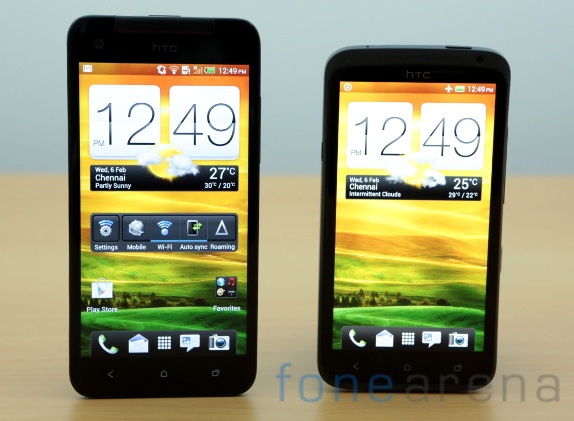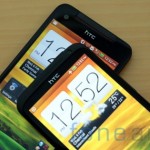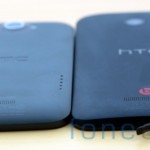
The HTC butterfly, as we know and love, is one of the first globally launched phones with a 1080p display. If you had read our Butterfly review, you would know how awesome the 1080p display on it is. But when the HTC One X released last year at the Mobile World Congress, it was one of the first devices to sport a 720p display. And right now, we are going to see if the display upgrade is worth it, and how far HTC has come with the Butterfly. Have they ironed out the kinks that were associated with the One series? We explain you, in a in-depth video comparison, watch and read past the break to get to know more.
httpv://www.youtube.com/watch?v=bW12NFm78xI
The HTC Butterfly’s design is a refinement of the One series design. It’s long in its 16:9 form factor, just like the One X, but even bigger. The One X on the other hand, is similar but has more curves to its body and is made of unibody polycarbonate, unlike the Butterfly’s 3 layer design. The Butterfly too, has its own differences, with a soft touch back and a complete glass layer on the front, with red accents on the sides made of stainless steel. Unlike the One X, the body of the Butterfly doesn’t envelope the front.
When it comes to dimensions, the Butterfly is comparatively bigger in size, but only in height, not width. The width remains the same, and the thickness and weight too, are not much of a difference. The Butterfly comes in at 9.08mm of thickness and weighs about 140g, the One X on the other hands comes at 8.9mm of thickness and weighs 130g. Although the Butterfly is slightly heavier than the One X, it feels lighter, probably due to a larger surface area and weight distribution.
The Butterfly being narrow with a soft touch back, has a slightly curved screen just like the One X and surprisingly it is a waterproof phone to some extent. Another major design change we like is that the power button is now in the center, rather than the uneasy top right like on the One X. Makes it easier to reach and use the button on the butterfly.
Lets talk about the major difference then, which is the display. The HTC Butterfly’s display is a 5 inch 16:9 1920×1080 display with a whopping 440 ppi. It has excellent viewing angles and colour accuracy with deep blacks. Thanks to lamination of the display onto the screen, the UI seems like it floats on the screen. The One X has a 720p 4.7 inch SLCD2 display. Compared to the Butterfly, the colours are slightly warmer in comparison. And the only difference we found in our testing between the 720p and the 1080p screen is that the text ever slightly jags out, only in the browser, with a web page fully zoomed out. This is not an ideal condition, so otherwise the pixel density on both the display are as good and not much of a difference, which leads to the question of a upgrade to a 1080p screen. The colours and blacks are as accurate and vibrant one the One X and it still holds its own, when it comes to comparison with other smartphone displays.
Regarding the internals, there are quite some differences. The butterfly has a Qualcomm Snapdragon S4 pro chip with a 1.5 GHz Quad core processor(APQ8064) and a Adreno 320 graphics chip. It has twice the amount of RAM as the One X at 2GB and the internal storage pegged at 16 GB. However the most interesting surprise with the Butterfly is the inclusion of a micro SD card slot, which is, by all means, a welcome change, and an annoyance from the One X fixed. The One X on the other hands runs on a Tegra 3 1.5 GHz Quad core processor with a companion core, has 1 GB RAM, and comes in 16 GB and 32 GB variants but alas, no expandable storage. Gaming on the One X is powered by a GeForce ULP GPU that has exclusive games with TegraZone and is a gaming powerhouse.
Coming to the camera on the Butterfly, it is a 8 MP sensor with a f2.0 lens. It can do FHD 1080p video and has a single LED flash. The ImageChip inside the phone helps you to capture 6 MP photos while recording video. Added abilities like software stabilisation are part of the whole Imagesense experience. There is also the 2.1 MP 1080 Front Facing Camera which is a step up from the 1.3 MP 720p camera on the One X’s front. From our tests, the One X and the Butterfly certainly have almost the same camera unit and if the rumours of the M7 are right, there is a lot more coming from HTC on the camera side to improve the things.
Another interesting change on the Butterfly is the 2020 mAH battery vs the 1800 mAH battery on the One X. One might argue that the display needs more, but the S4 pro chip seems more efficient that Tegra 3 and from our tests, the HTC Butterfly seems better overall, in battery performance.
Software is a non-issue in comparison between these two devices because they both essentially run on the same software. They run on Android 4.1.1 Jellybean with the Sense 4+ UI layer on top. Sense has a long way to go when in comparison with other skins, and that’s all we have to say regarding the software. Other minor changes with the Butterfly include the lack of a NFC chip, which is present on the One X. Bizarre, but that’s how it is!
So, that’s the comparison of the HTC Butterfly vs the One X. Do let us know your thoughts in the comments section below and remember to check out our YouTube channel for more comparison videos like these. The video go up first, so you might want to subscribe to our channel to receive the comparisons as soon as it is published.
P.S – more photos below.








